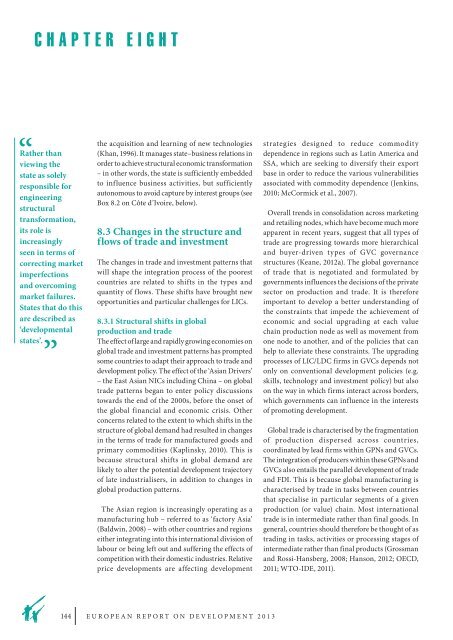Post 2015: Global Action for an Inclusive and Sustainable Future
Post 2015: Global Action for an Inclusive and Sustainable Future
Post 2015: Global Action for an Inclusive and Sustainable Future
Create successful ePaper yourself
Turn your PDF publications into a flip-book with our unique Google optimized e-Paper software.
CHApTER EIgHT<br />
Rather th<strong>an</strong><br />
viewing the<br />
state as solely<br />
responsible <strong>for</strong><br />
engineering<br />
structural<br />
tr<strong>an</strong>s<strong>for</strong>mation,<br />
its role is<br />
increasingly<br />
seen in terms of<br />
correcting market<br />
imperfections<br />
<strong>an</strong>d overcoming<br />
market failures.<br />
States that do this<br />
are described as<br />
‘developmental<br />
states’.<br />
144<br />
the acquisition <strong>an</strong>d learning of new technologies<br />
(Kh<strong>an</strong>, 1996). It m<strong>an</strong>ages state–business relations in<br />
order to achieve structural economic tr<strong>an</strong>s<strong>for</strong>mation<br />
– in other words, the state is sufficiently embedded<br />
to influence business activities, but sufficiently<br />
autonomous to avoid capture by interest groups (see<br />
box 8.2 on côte d’Ivoire, below).<br />
8.3 Ch<strong>an</strong>ges in the structure <strong>an</strong>d<br />
flows of trade <strong>an</strong>d investment<br />
the ch<strong>an</strong>ges in trade <strong>an</strong>d investment patterns that<br />
will shape the integration process of the poorest<br />
countries are related to shifts in the types <strong>an</strong>d<br />
qu<strong>an</strong>tity of flows. these shifts have brought new<br />
opportunities <strong>an</strong>d particular challenges <strong>for</strong> lIcs.<br />
8.3.1 Structural shifts in global<br />
production <strong>an</strong>d trade<br />
the effect of large <strong>an</strong>d rapidly growing economies on<br />
global trade <strong>an</strong>d investment patterns has prompted<br />
some countries to adapt their approach to trade <strong>an</strong>d<br />
development policy. the effect of the ‘asi<strong>an</strong> Drivers’<br />
– the East asi<strong>an</strong> nIcs including china – on global<br />
trade patterns beg<strong>an</strong> to enter policy discussions<br />
towards the end of the 2000s, be<strong>for</strong>e the onset of<br />
the global fin<strong>an</strong>cial <strong>an</strong>d economic crisis. other<br />
concerns related to the extent to which shifts in the<br />
structure of global dem<strong>an</strong>d had resulted in ch<strong>an</strong>ges<br />
in the terms of trade <strong>for</strong> m<strong>an</strong>ufactured goods <strong>an</strong>d<br />
primary commodities (Kaplinsky, 2010). this is<br />
because structural shifts in global dem<strong>an</strong>d are<br />
likely to alter the potential development trajectory<br />
of late industrialisers, in addition to ch<strong>an</strong>ges in<br />
global production patterns.<br />
the asi<strong>an</strong> region is increasingly operating as a<br />
m<strong>an</strong>ufacturing hub – referred to as ‘factory asia’<br />
(baldwin, 2008) – with other countries <strong>an</strong>d regions<br />
either integrating into this international division of<br />
labour or being left out <strong>an</strong>d suffering the effects of<br />
competition with their domestic industries. relative<br />
price developments are affecting development<br />
EuropE<strong>an</strong> rEport on DEvElopmEnt 2013<br />
strategies designed to reduce commodity<br />
dependence in regions such as latin america <strong>an</strong>d<br />
SSa, which are seeking to diversify their export<br />
base in order to reduce the various vulnerabilities<br />
associated with commodity dependence (Jenkins,<br />
2010; mccormick et al., 2007).<br />
overall trends in consolidation across marketing<br />
<strong>an</strong>d retailing nodes, which have become much more<br />
apparent in recent years, suggest that all types of<br />
trade are progressing towards more hierarchical<br />
<strong>an</strong>d buyer-driven types of Gvc govern<strong>an</strong>ce<br />
structures (Ke<strong>an</strong>e, 2012a). the global govern<strong>an</strong>ce<br />
of trade that is negotiated <strong>an</strong>d <strong>for</strong>mulated by<br />
governments influences the decisions of the private<br />
sector on production <strong>an</strong>d trade. It is there<strong>for</strong>e<br />
import<strong>an</strong>t to develop a better underst<strong>an</strong>ding of<br />
the constraints that impede the achievement of<br />
economic <strong>an</strong>d social upgrading at each value<br />
chain production node as well as movement from<br />
one node to <strong>an</strong>other, <strong>an</strong>d of the policies that c<strong>an</strong><br />
help to alleviate these constraints. the upgrading<br />
processes of lIc/lDc firms in Gvcs depends not<br />
only on conventional development policies (e.g.<br />
skills, technology <strong>an</strong>d investment policy) but also<br />
on the way in which firms interact across borders,<br />
which governments c<strong>an</strong> influence in the interests<br />
of promoting development.<br />
<strong>Global</strong> trade is characterised by the fragmentation<br />
of production dispersed across countries,<br />
coordinated by lead firms within Gpns <strong>an</strong>d Gvcs.<br />
the integration of producers within these Gpns <strong>an</strong>d<br />
Gvcs also entails the parallel development of trade<br />
<strong>an</strong>d FDI. this is because global m<strong>an</strong>ufacturing is<br />
characterised by trade in tasks between countries<br />
that specialise in particular segments of a given<br />
production (or value) chain. most international<br />
trade is in intermediate rather th<strong>an</strong> final goods. In<br />
general, countries should there<strong>for</strong>e be thought of as<br />
trading in tasks, activities or processing stages of<br />
intermediate rather th<strong>an</strong> final products (Grossm<strong>an</strong><br />
<strong>an</strong>d rossi-H<strong>an</strong>sberg, 2008; H<strong>an</strong>son, 2012; oEcD,<br />
2011; Wto-IDE, 2011).

















